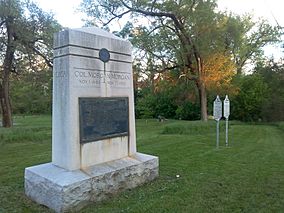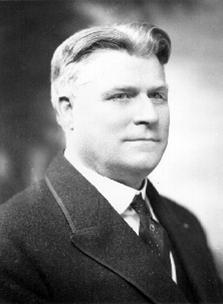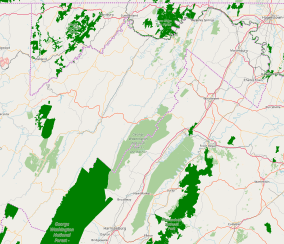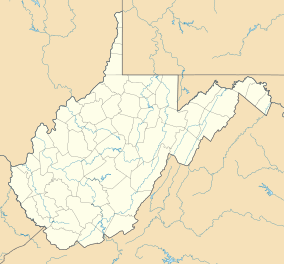Morgan Morgan Monument facts for kids
Quick facts for kids Morgan Morgan Monument |
|
|---|---|

Morgan Morgan Monument
|
|
| Location | Bunker Hill, Berkeley, West Virginia, United States |
| Area | 1.05 acres (0.42 ha) |
| Elevation | 549 ft (167 m) |
| Established | 1924 |
| Named for | Morgan Morgan |
The Morgan Morgan Monument, also known as Morgan Park, is a small park in Bunker Hill, West Virginia. It covers about 1 acre (0.42 hectares). The park is located along Winchester Avenue (U.S. Route 11) and Mill Creek.
The main feature of the park is a large stone monument. This monument was built in 1924. It honors Morgan Morgan (1688–1766). He was an early American pioneer from Wales. Morgan Morgan was one of the first European settlers to live permanently in what is now West Virginia.
The West Virginia Legislature (the state's law-making body) set aside money in 1923 to build the monument. Ephraim F. Morgan, who was the Governor of West Virginia and a descendant of Morgan Morgan, helped with the project. He chose a committee of three people to plan and watch over the monument's construction. These people were Haze Morgan (another descendant), Blanche M. Pickering, and State Senator Harry P. Henshaw. The monument was officially revealed and dedicated on September 13, 1924. Governor Morgan gave the main speech at the ceremony.
At first, the West Virginia Monuments Commission owned the monument. Then, in 1924, it was given to the West Virginia Road Commission. They took care of it as a roadside park until 1956. From 1956 to 1970, the park was managed by the West Virginia Conservation Commission. It was even a West Virginia state park for a while. It was the only state park ever in Berkeley County. In 1970, the West Virginia Road Commission (now called the West Virginia Division of Highways) took over again. They still maintain the monument as a roadside park today. In 1980, the Morgan Morgan Monument and its park became part of the Mill Creek Historic District. This district is listed on the National Register of Historic Places, which recognizes important historical sites.
Contents
Location and Features
The Morgan Morgan Monument, also known as Morgan Park, is a 1.05-acre (0.42-hectare) park. It includes the 1924 granite monument to Morgan Morgan. There are also two West Virginia highway markers just south of the monument. One marker tells a short story about Morgan Morgan's life. The other describes a place called Morgan Acres, which might be where Morgan built his first simple shelter.
The monument is located in the small community of Bunker Hill. This area is in Berkeley County, West Virginia. The park is next to Winchester Avenue (U.S. Route 11) on its west side. Mill Creek flows along the park's south side. The park is about 9.6 miles (15.4 km) southwest of Martinsburg. It is also about 11.9 miles (19.2 km) northeast of Winchester, Virginia.
|
Morgan Morgan Monument
|
|
|
U.S. Historic district
Contributing property |
|
| Location | Winchester Avenue (U.S. Route 11), Bunker Hill, West Virginia |
|---|---|
| Area | 1.05 acres (0.4 ha) |
| Built | 1924 |
| Part of | Mill Creek Historic District (ID80004420) |
| MPS | Berkeley County MRA |
| Added to NRHP | December 10, 1980 |
The Morgan Morgan Monument is part of the Mill Creek Historic District. This area has several properties connected to the Morgan family. These properties are also listed on the National Register of Historic Places (NRHP). For example, the monument is about 1,279 feet (390 m) northeast of the Morgan Chapel and Graveyard. This is where Morgan Morgan and his family are buried. Morgan's son David built a house that became part of the Morgan-Gold House, which is 1.3 miles (2.1 km) west of the monument. The William G. Morgan House is 2.4 miles (3.9 km) west. Cool Spring Farm, where Morgan's son Zackquill Morgan lived, is 2.7 miles (4.3 km) west.
History of Morgan Morgan
Early Settlement in West Virginia
The monument honors Morgan Morgan (1688–1766). He was an American pioneer of Welsh background. He was one of the first Europeans to settle permanently in what is now West Virginia.
The land where the monument stands was once part of a huge land grant. This grant was called the Northern Neck Proprietary. It was given by King Charles II of England to some of his supporters in 1649. Later, the grant was passed down through different owners. Eventually, in 1719, it came to Thomas Fairfax, 6th Lord Fairfax of Cameron.
Morgan Morgan arrived in the Bunker Hill area around 1731. At that time, it was part of Spotsylvania County. He received a land grant of 1,000 acres (400 hectares) on December 12, 1735. Morgan is thought to be the first European to settle permanently in present-day West Virginia. However, some German settlers might have lived in Shepherdstown as early as 1727.
Morgan became very involved in local government. He was appointed a justice of the peace for Spotsylvania County in 1734. When Orange County was created later that year, Morgan continued as a justice of the peace there. He also served as a captain in the Orange County militia. Morgan helped build roads and improve the area. He is known for developing a route between Bunker Hill and Winchester. He also ran an "ordinary," which was like a small inn or tavern, on his property.
Morgan was important in creating Frederick County from Orange County in 1738. He served as a justice of the peace for Frederick County when its court began in 1743. Morgan was also a vestryman (a church leader) for the Frederick Parish of the Anglican Church. Around 1740, he helped start what is now West Virginia's first Anglican church. It was first a log building called Morgan's Chapel. After being rebuilt in 1851, it became Christ Episcopal Church. Morgan Morgan and his family are buried in the church's cemetery. After Morgan's death, Berkeley County was created from Frederick County in 1772.
Morgan's first log cabin was built between 1731 and 1734. This cabin was rebuilt and restored in 1976. Many of its original logs were used. In 1994, wood siding was added to protect the logs. This cabin, known as the Morgan Cabin, is located on the Cool Spring Farm property. It is about 2.74 miles (4.41 km) west of the monument. The Berkeley County Historical Landmarks Association owns and manages the Morgan Cabin and Cool Spring Farm.
Building the Monument
In 1923, the West Virginia Legislature passed a bill. This bill set aside $5,000 for a monument to Morgan Morgan in Bunker Hill. Ephraim F. Morgan, the Governor of West Virginia, approved the bill. He was a direct descendant of Morgan Morgan. The bill stated that Morgan Morgan was "a man of high character." It said he was very helpful in the community he founded. The monument was meant to remember his life and actions. Half of the money was given in 1924, and the rest in 1925. The monument was supposed to be near Morgan's burial site at Morgan Chapel.
The bill said the monument would be planned by the Morgan Morgan Monument Commission. This commission would have three members chosen by the Governor. On January 2, 1924, Governor Morgan appointed the committee. It included Haze Morgan (chairman), Blanche M. Pickering, and State Senator Harry P. Henshaw. The commission bought a 1.05-acre (0.42-hectare) piece of land for $420 to build the monument.

The granite Morgan Morgan Monument was built in 1924. It was officially revealed and dedicated on September 13, 1924. The ceremony was organized by several chapters of the Daughters of the American Revolution (DAR). Governor Morgan was the main speaker. He accepted the monument for the state of West Virginia. Charles James Faulkner, a former U.S. Senator from West Virginia, also spoke. He talked about Morgan and Berkeley County's early history. Local students from Bunker Hill sang in a chorus. Anna Mildred Morgan, a descendant of Morgan, unveiled the monument. A prayer was given by Rev. J. L. Oldham, the leader of Morgan Chapel. The DAR chapter also planted a tree near the monument. Hundreds of people attended the ceremony. Many were from the local area and nearby cities. A family reunion for Morgan Morgan's descendants was also held.
Later in 1924, the West Virginia Monuments Commission gave the monument site to the West Virginia Road Commission. They felt the Road Commission could maintain it better. After this, the park added a tourist camp. It became the first free public tourist attraction in West Virginia. Local groups sometimes used the roadside park for events.
Park Management and Recognition
In 1925, the Legislature created the State Forest, Park and Conservation Commission. This group studied the needs for forests, parks, and recreation areas in West Virginia. In 1927, they suggested creating a State Monument System. They listed existing historical monuments to be included. These included the Grave Creek Mound, the Point Pleasant Monument, the James Rumsey Monument, and the Morgan Morgan Monument.
In 1956, the Morgan Morgan Monument and Roadside Park became part of the West Virginia state parks system. It was managed by the West Virginia Conservation Commission's Division of State Parks. It was the only state park ever in Berkeley County. The monument was overseen by Cacapon Resort State Park in nearby Omps. In 1960, the National Park Service (NPS) listed the Morgan Morgan Monument as a "state monument." The NPS noted that the small park did not have water activities, overnight stays, or places to eat.
In 1962, the monument was a stop on the Annual House and Garden Tour. This tour visited Shepherdstown, Martinsburg, Charles Town, and Harpers Ferry. Between 1963 and 1964, 1,500 visitors came to the Morgan Morgan Monument. This was the lowest number for any state park at the time. A 1964 NPS survey said the Morgan Morgan Monument was a "day and weekend use" park. Its main importance was its history. In 1966, two West Virginia highway markers were put in the park. One told about Morgan, and the other about Morgan Acres. In early 1970, the monument and park were given back to the West Virginia State Road Commission. This group later became the West Virginia Division of Highways. The Morgan Morgan Monument became a contributing property of the Mill Creek Historic District on the NRHP on December 10, 1980.
Monument Details
The Morgan Morgan Monument is a tall granite stone. It came from Barre, Vermont. It stands on a concrete base. The monument is 12.5 feet (3.8 m) tall. At the top of the front (western) side, there is a 10-inch (25 cm) medallion of the Seal of West Virginia. Below the seal, the stone has an inscription: "COL. MORGAN MORGAN NOV. 1, 1688 – NOV. 17, 1766". Below this, a plaque reads:
ERECTED BY THE STATE OF WEST VIRGINIA
In commemoration of the first settlement within the present boundaries of said State, which was made by Col. Morgan Morgan, a native of Wales, and Catherine Garretson, his wife, in the year 1726 on a tract of 1000 acres about 2 miles west of here.
Granted to him by colonial Virginia patent, and in recognition of the sterling character of the said Morgan and family who by their efforts and example, were largely useful in the community of which he was the founder and had great influence for good upon the early history of the territory now constituting this State. His grave (marked) is nearby, adjacent Christ's Episcopal Church formerly called Morgan's Chapel, the oldest church in this State, which he helped organize and build.
Commissioners:
Ephraim F. Morgan, Governor of W. Va.
Harry P. Henshaw, State Senator;
Mrs. Blanche M. Pickering;
Haze Morgan.A.D. MCMXXIV.





